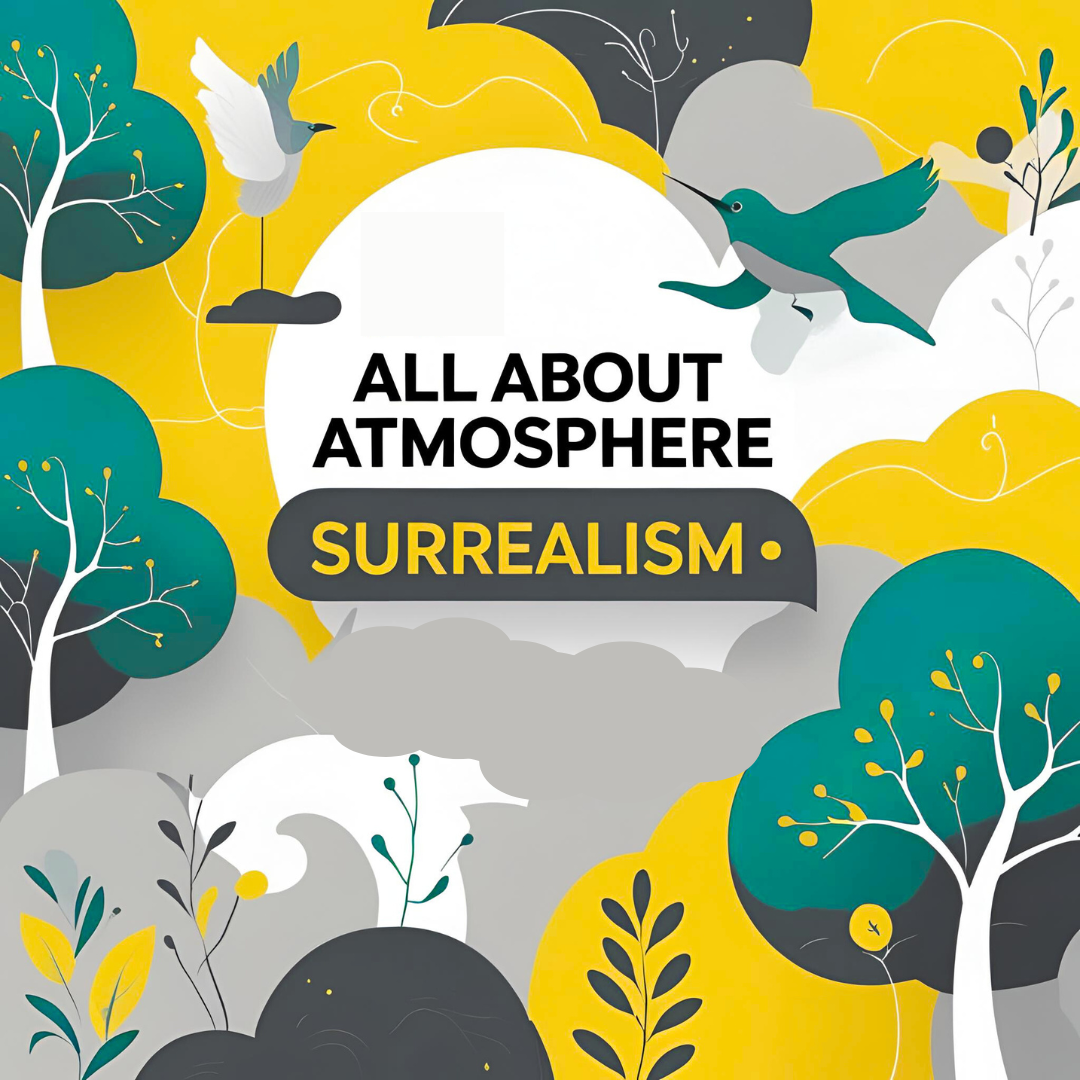By Eliana Fulton
Sometimes reading can feel like falling into a rabbit hole. The author illustrates through their words so wonderfully that letters on a page feel more like an adventure in a new world. There is a theme, yes, but also an experience, as if opening up the cover transported its reader to a vibrant expedition. As writers, we close the magical covers and wish for a way to make that world ourselves.
Literature and art have more in common than we think. Many atmospheres of literature were first inspired by architecture, sculptures, or paintings. To create these atmospheres for ourselves, we must pick up a paint brush and find the paints that wash the canvas in our own, just as captivating way.
In the last All About Atmosphere post, we inspected Decadent Literature as a study in emulating historical movements, but atmosphere can do so much more than that. Creative writers have the capability to make new worlds entirely. With the right colorful language, they can turn our perspectives upside down and backwards.
Suddenly reality looks like bright cartoon shapes or watercolor ripples. It’s beautiful and enjoyable, but we’re writers, not artists. How can the atmosphere of a text be like art? What do we turn to when the rules of world building are tossed out the window? How bizarre is too far?
Luckily, letting go of the rules does not have to mean floundering for solid ground to stand on. In order to understand how to melt down and transform the climate of our writing, we need to look at examples and see what elements work best.
Surrealism
In the wake of both World Wars, existentialism and Freudian psychoanalysis crept their way into literary conversations. In a time where so many people died or experienced trauma, surrealism was a way of divesting the unpredictability of life. An era of surrealist literature swept through imaginative thinkers.
Surrealism is a creative release that explores the unconscious mind through wild juxtaposition, illogical structures, and absurdity. This atmosphere’s purpose is questioning life’s uncertainty by liberating characters from the tyranny of rationality. Surrealist fiction pulls readers into a waking dream where they never know what to expect.
This is an atmosphere for the skeptics, because it focuses on searching for meaning as a beautiful human experience rather than a gateway to answers. In The Hitchhiker’s Guide to the Galaxy by Douglas Adams, the characters are desperate for the answer to “life, the universe, and everything,” only to find the answer “42” hopelessly disappointing. This is the epitome of surrealism, because we know that there is more to learn from the lack of a coherent answer, than any real advice would have given us.
Hero’s Journey Rules
Surrealism does not follow literary rules as you will see in the next section, but there is a general outline that a production story adheres to. We’ve all heard of the Hero’s Journey (if not no worries you can find it online. Surrealism does build off of the bones of this guideline:
Ordinary World
Call to Action
Refusal of the Call
Crossing the Threshold into the “Special World”
The Ordeal
Return to the Ordinary World
However, the illogical nature of this atmosphere allows authors to play scrapbook with these steps. They do not need to be in the same order because time does not work the same in surrealism. Also, that in-adherence to chronology means that the “Special World” is usually more of a void. The characters do not have to be under a time constraint because it’s more important that they solve their existential crisis.
Dream Logic
We’ve all had crazy dreams. One minute you’re in your childhood home eating a weird snack with your favorite cartoon character, and the next you’re in the White House on a scavenger hunt. Things that seem really important in one part of the dream disappear completely in the next part. You do and say things that you would never if you were awake. If you talked to a psychologist they might interpret what your subconscious mind tried to tell you. Perhaps you need to heal your inner child to reach your ambitions of being the president.
This non-linear and fever dream coded haze is the primary base for surrealism literature. The plot should not be straightforward or simple, it should drift and spike or loop back around. In Slaughterhouse 5 by Kurt Vonnegut, time is a plain in which people can be in any moment whenever they’re like. The book jumps between a future on another planet, the past in the war, and other times as if they are all happening simultaneously. As an author, you’re at liberty to regulate time however you want. It doesn’t need to be crazy but it shouldn’t feel like real life.
In addition, the illogical nature of the circumstances still needs to reveal things about the subconscious of the main character or characters. The randomness of the alternate reality should correspond with the protagonist’s inner conflict.
Wild Juxtaposition
Juxtaposition is every writer’s favorite way of making something stand out. Bring two opposites next to each other and we suddenly understand their qualities on a whole new level. In this atmosphere juxtaposition has more to do with shaking up reality. It’s all about disruption, disorientation, and discovery.
There can be weird symbolism through irrational combinations like a cabin made of spicy pickles or a shark with a degree in engineering. This plays along with the dream-like logic. Doors don’t have to go to the next room, and directions don’t have to make sense. All of these contrasts serve to challenge the character’s perceptions and provoke comfort with the uncomfortable.
Metaphor
In the spirit of wild juxtaposition, a practical application is implementing lots and lots of strange and excessive metaphors. The descriptions of the surreal world that the character steps into, should be sporadic and random. Something isn’t just as small as a mustard seed, it's smaller than the crumb from the smallest house in a village of tiny people that resides on the tip of a dandelion hair in Montana. An apple isn’t as red as a fire truck, it's redder than the cheeks of the robin birds when you catch them bathing in the fountain.
Stream of Consciousness
The surrealist writing style is authentic and automatic. There is no drafting strategy when the plot doesn’t have to make sense—just write! Dreams flow with the subconscious, so the text should take time to organize and think.
This can result in strange syntax, fragmented narratives, or uncanny metaphors. You’re free from the pressures of structure and control because those ideas confine your creativity.
For some writers this may come easily, but for others it takes concerted effort to flow without construction and planning. The disjointed logic unburdens us from over-clarifying the direction of the text.
Alienation
People with an abundance of friends, families, and activities tend to know what their purpose in life is. It’s hard to be surrounded by love and a clear cause and still want some intangible, existential answers. Therefore, surrealist protagonists are commonly isolated people, alienated by their social groups.
Without an existing support system, these characters can turn to the alternate or strange and irrational situation that the plot pulls them to. They should not have a lot tying them down to their current life, so they take this opportunity to break away from the dregs of their reality. Those “dregs” might be war, capitalism, or even just conformity.
In your surrealist story they will enter a void of existential dread, but also newfound wonder. The elements emphasized in the void contrast the character’s initial disconnection to critique the harsh pressure of reality.
Rebellion Against Rationalism
In statistics there is a phenomenon called Spurious Correlations. These are statistical analysis datum that correlate with no discernible reason. For example, the popularity of the name Waylon and the amount of wind power in China correlate between 1990 and 2020.
Spurious correlation is a way of illustrating that correlation does not always mean causation. Surrealism defies necessity for reason in a similar way. It is an outlandish representation of how sporadic life can be to remind us that some things don’t have any rational explanation.
The rebellious attitude takes this demonstration even further. Rationalism is a sort of suppressant on our reality, always forcing us to look for explanations, but by rebelling against the need for a clear answer, the characters of surrealism can find contentment in their situations.
Seeker of Truth
The journey of surrealist novels revolve around the main character unraveling misconceptions about the logic of reality. Their desire is an insatiable need for answers, and their barrier is that the answers don’t exist. Your job as an author is to give them more reasons to ask questions, and slowly pull the answers further away.
Big Question
At the heart of a surrealist novel is at least one BIG question. We all have these, and the response to any of them changes depending on who you ask.
What is the meaning of life? Why do people die? What does it mean to “grow up”?
Vocabulary
This atmosphere is very malleable, so while I will provide some diction to set the tone, I would prefer it be more of an inspiration. This literary journey is what you make it, so it can be darker and mysterious, or more light and whimsical.
Subconscious bloom
Logic of the fog
Thoughts dripping like wax
Clocks melting over teacups
A violin made of glass teeth
Laughter stitched into wallpaper
Moonbeam ice cream
Hands blooming into orchids
Oracles of dust
Keyhole
Time folded like linen in her lap
Crown of moths
Dreams
Skin turning to smoke
The sky forgot its color
The thought finishes itself and walks away
In the rapping and tapping of this spindling typing I worry I may have written backwards and upside down. As my shouts become whispers in fading wallpaper, please drink them up before returning to the dim, dark world of drafting. How do I know that people will read the words I lay down like a babe in a crib, you ask? A legacy of lunacy is easy to bake into the world, but one of greatness, is as unpredictable as a cat in a box with a vial of poison. Life is as lonely as an ant far away from its colony, sitting on my window sill. But just as we cannot know where that one sock out of a pair disappeared to, we cannot know what people will think of our writing when we die, as these scribblings dissolve into mist and memory.
Thank you!
These atmosphere posts have been so fun to write! If you have not already, go read our posts of Gothic literature and Decadence.


